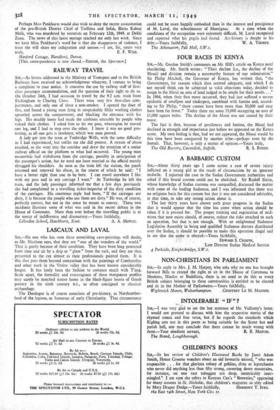LASCAUX AND LAVAL
Sut,—No one who has seen these astonishing cave-paintings will doubt, as. Mr. Nicolson says, that they are " one of the wonders of the world." That is partly because of their condition. They have been long protected from time and air by -a drip or " glaze " from the rock, and they are thus presented to the eye almost as their professionals painted them. It is this that puts them beyond comparison with the paintings of Combarelles and other work in the Vezere valley that has been known considerably longer. It has lately been the fashion to compare much with 'rang. Scale apart, the formality and extravagance of these manganese profiles may surely be matched nearer home in the black-figure beasts of Greek pottery in the sixth -century B.C., so often consigned to classical archaeology.
The Dordogne is of course conscious of pre-history, as Northumber- land of the legions, or Somerset of early Christianity. That circumstance
could not be more happily embodied than in the interest and percipience of M. Laval, the schoolmaster. of Montignac. At a time when the conditions of the occupation were extremely difficult, M. Laval recognised and reported what his pupils had found. Art-history is deeply in his
debt.—Yours faithfully, W. A. THORPE. The Athenaeum, Pall Mall, S.W.r.






































 Previous page
Previous page